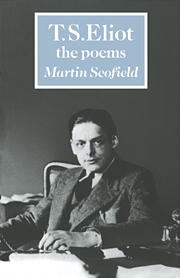Book contents
- Frontmatter
- Contents
- Acknowlegements
- Chronology
- Introduction
- 1 Aspects of the life of the poet
- 2 Early poetic influences and criticism, and Poems Written in Early Youth
- 3 Prufrock and Other Observations (1917)
- 4 Poetic theory and poetic practice
- 5 Poems (1920)
- 6 The Waste Land (1922)
- 7 From The Hollow Men (1925) to ‘Marina’ (1930)
- 8 Poetry, pattern and belief
- 9 From Coriolan (1931) to ‘Burnt Norton’ (1936)
- 10 ‘Burnt Norton’ (1936) and the pattern for Four Quartets
- 11 The wartime Quartets (1940–2)
- Notes
- Select bibliography
- Index
11 - The wartime Quartets (1940–2)
Published online by Cambridge University Press: 18 January 2010
- Frontmatter
- Contents
- Acknowlegements
- Chronology
- Introduction
- 1 Aspects of the life of the poet
- 2 Early poetic influences and criticism, and Poems Written in Early Youth
- 3 Prufrock and Other Observations (1917)
- 4 Poetic theory and poetic practice
- 5 Poems (1920)
- 6 The Waste Land (1922)
- 7 From The Hollow Men (1925) to ‘Marina’ (1930)
- 8 Poetry, pattern and belief
- 9 From Coriolan (1931) to ‘Burnt Norton’ (1936)
- 10 ‘Burnt Norton’ (1936) and the pattern for Four Quartets
- 11 The wartime Quartets (1940–2)
- Notes
- Select bibliography
- Index
Summary
After the writing of ‘Burnt Norton’ Eliot turned back first to writing for the stage, and The Family Reunion appeared in 1939. It was the outbreak of war in September of that year that appears more than anything else to have impelled him to return to the more inward and searching exploration of experience which ‘Burnt Norton’ had represented. In the interview in 1953 already referred to in Chapter 9 Eliot recalled that it was the war which turned him away from his preoccupation with drama and towards the writing of ‘East Coker’, and that it was in writing that poem that he came to see the Quartets as a set of four. The three wartime Quartets, which take ‘Burnt Norton’ as their structural model, are essentially an attempt to explore the implications of that poem in relation to wider areas of personal experience, religion, culture and history: they establish a fuller relationship of the experience of the earlier poem to a public world at the same time as they continue the exploration of the self. It is difficult and probably not desirable to try and pin each of the remaining quartets down to a single ‘subject’: as Eliot said in a letter, after suggesting that Part IV of ‘East Coker’ (‘The wounded surgeon plies the steel’) was ‘in a way the heart of the matter’, ‘the poem as a whole – this five part form – is an attempt to weave several unrelated strands together in an emotional whole, so that really there isn't any heart of the matter’.
- Type
- Chapter
- Information
- T. S. Eliot: The Poems , pp. 214 - 242Publisher: Cambridge University PressPrint publication year: 1988



